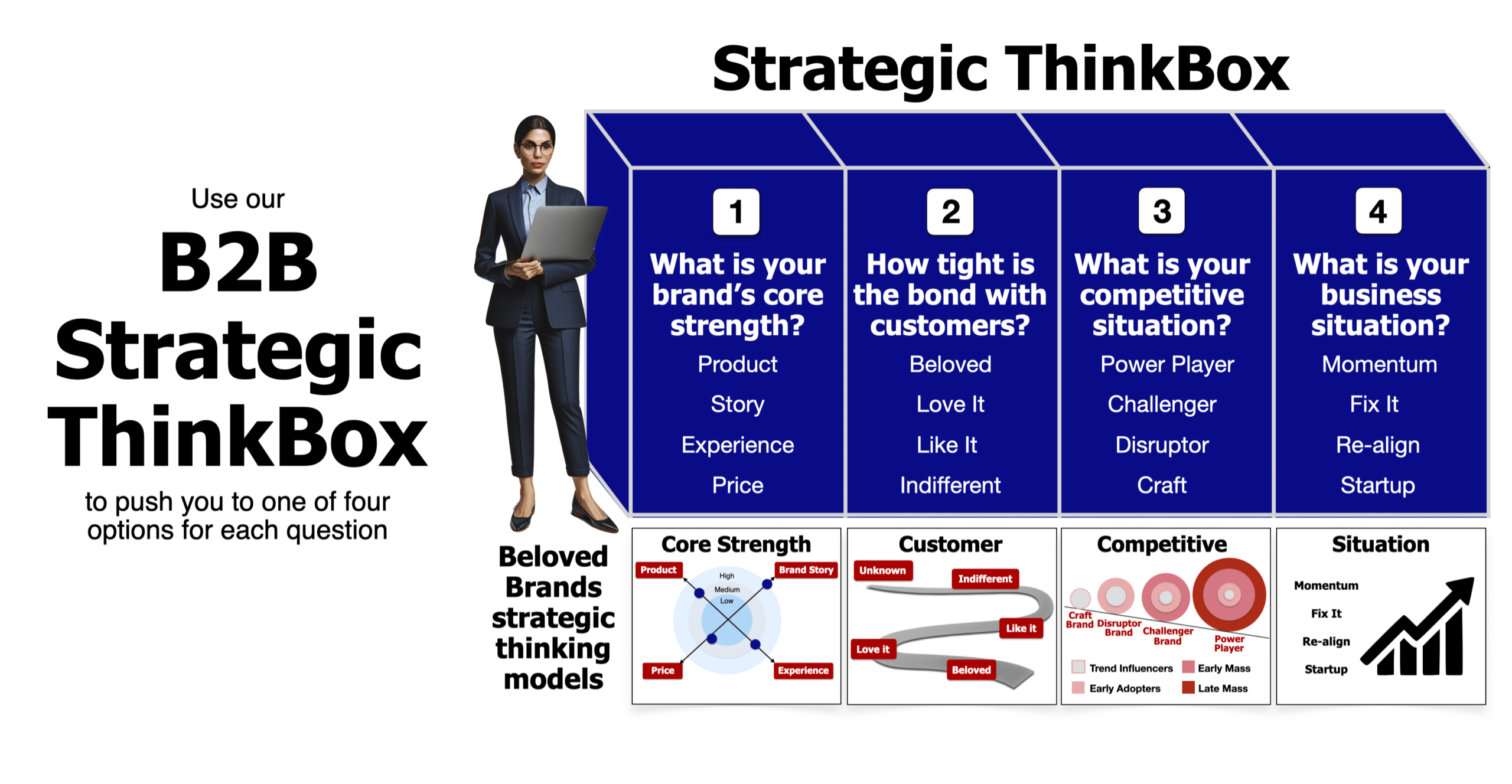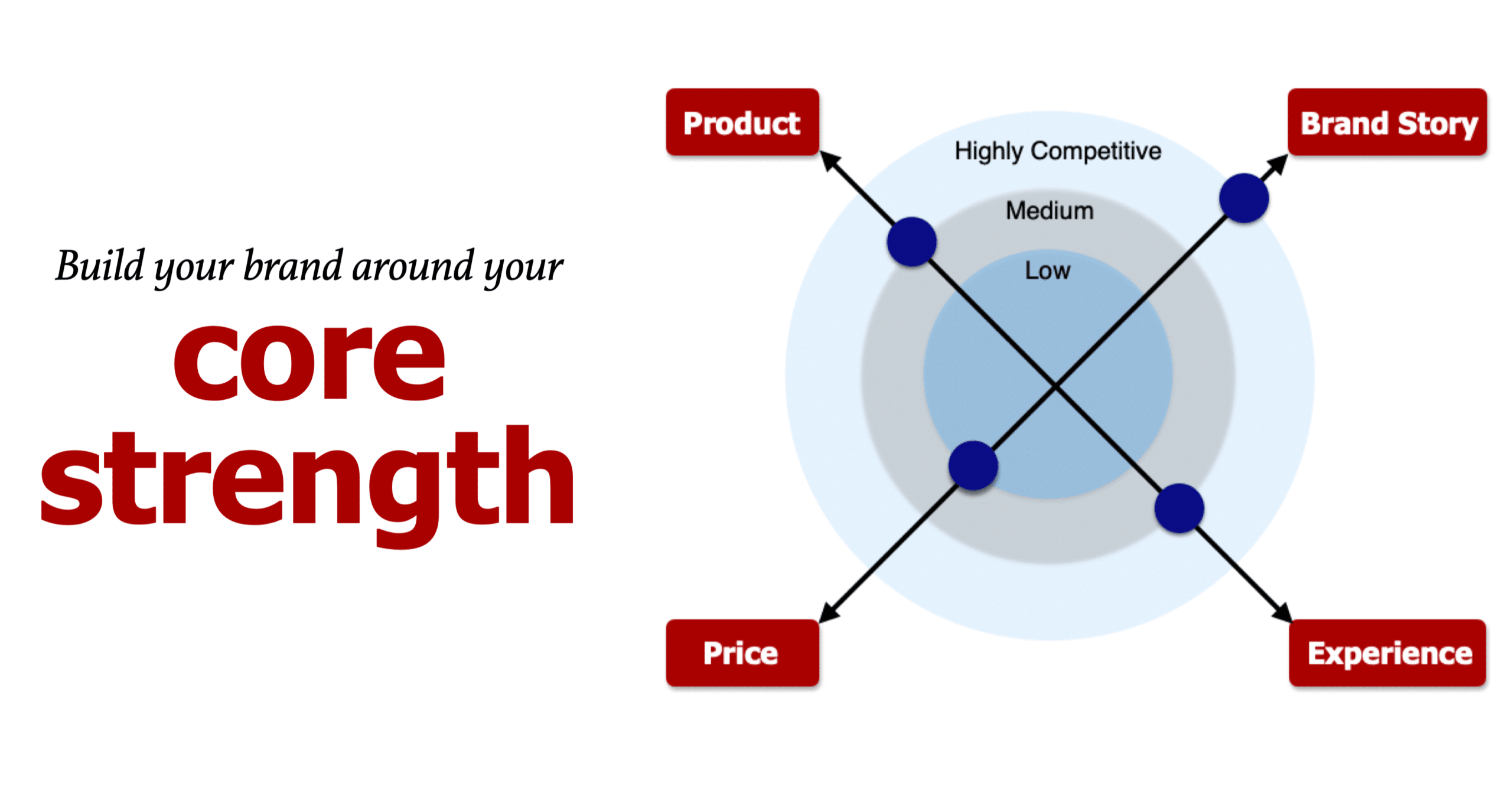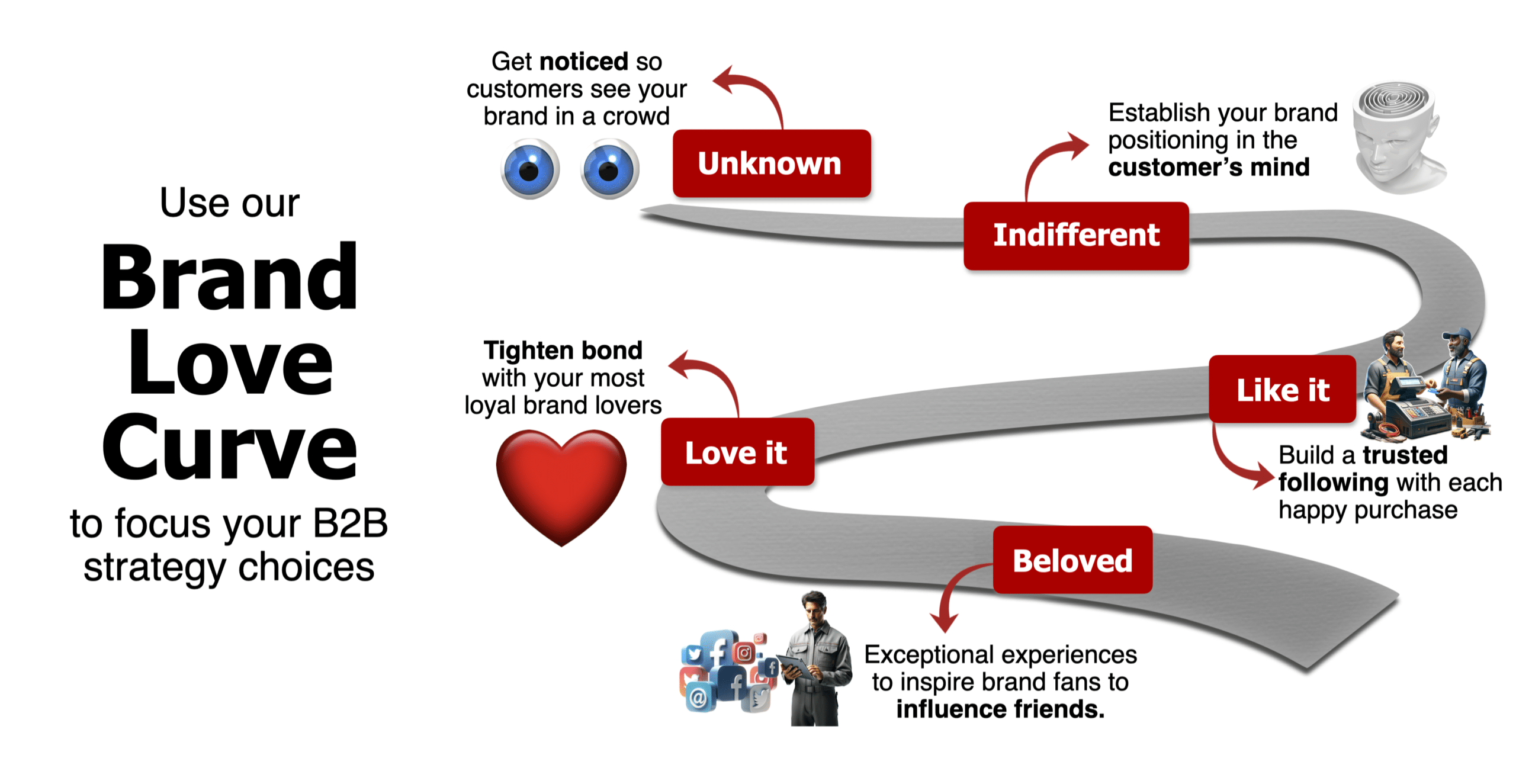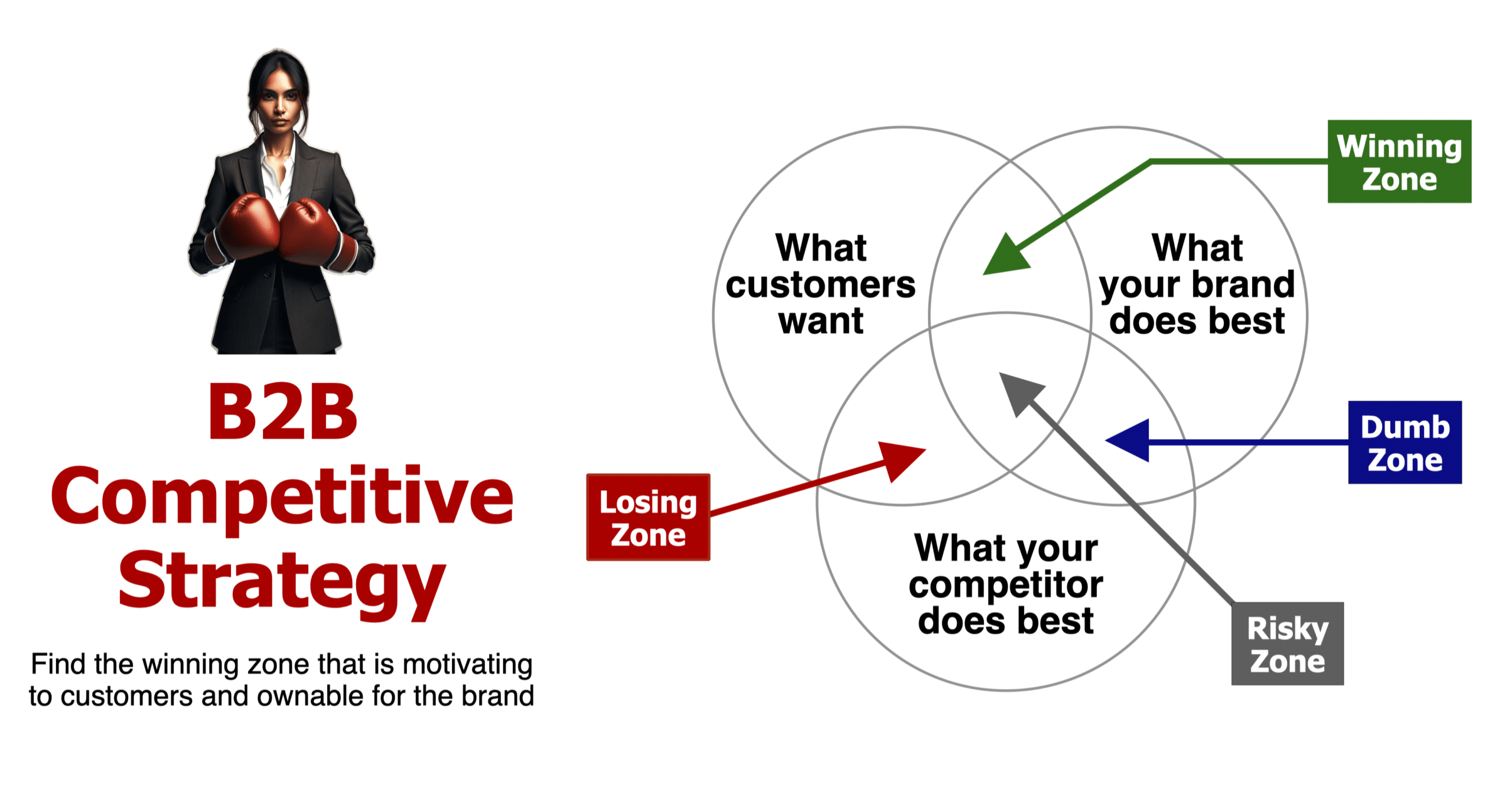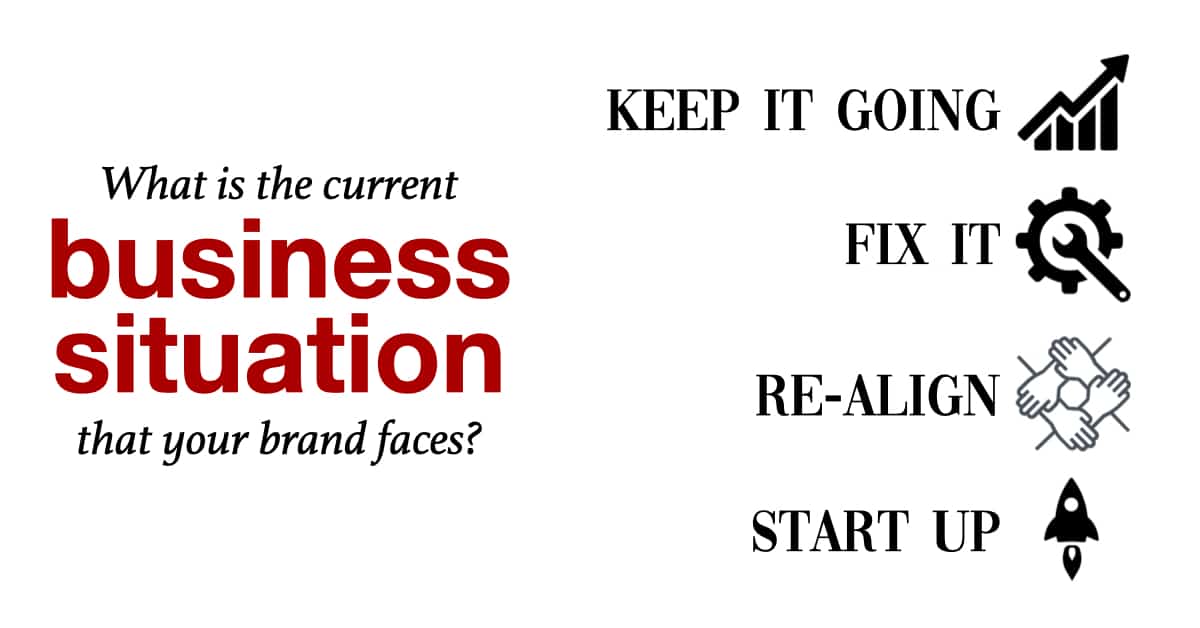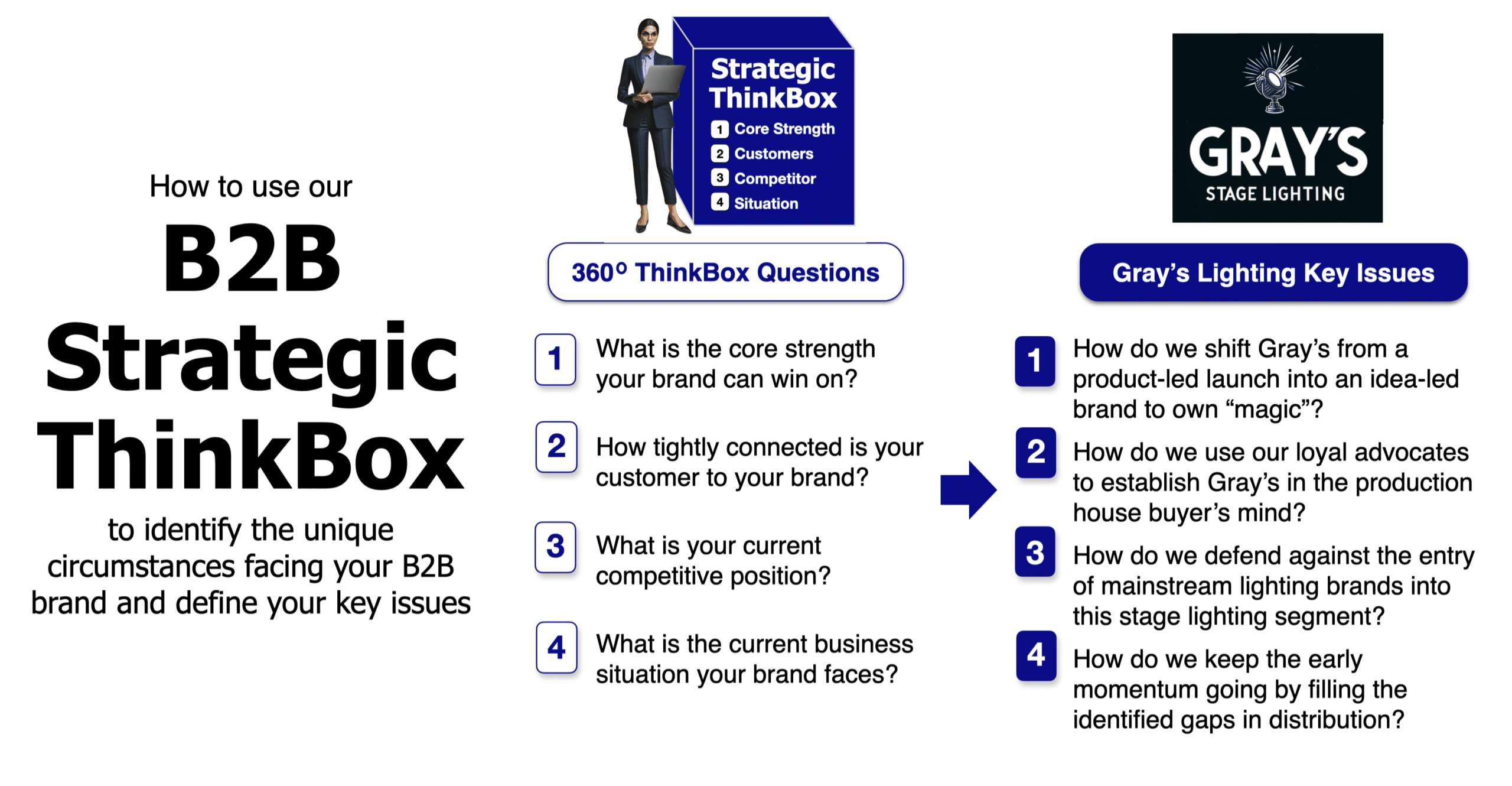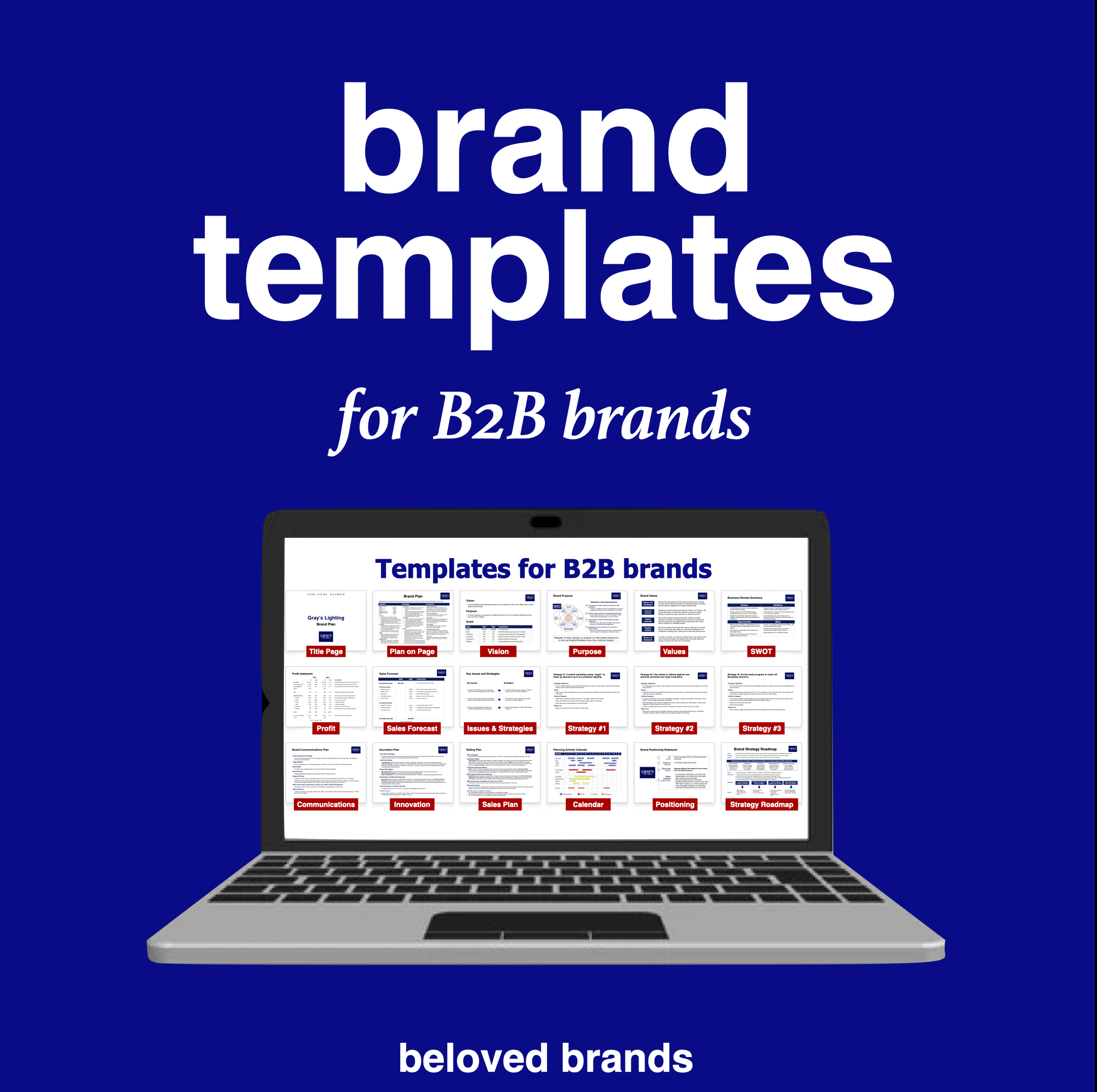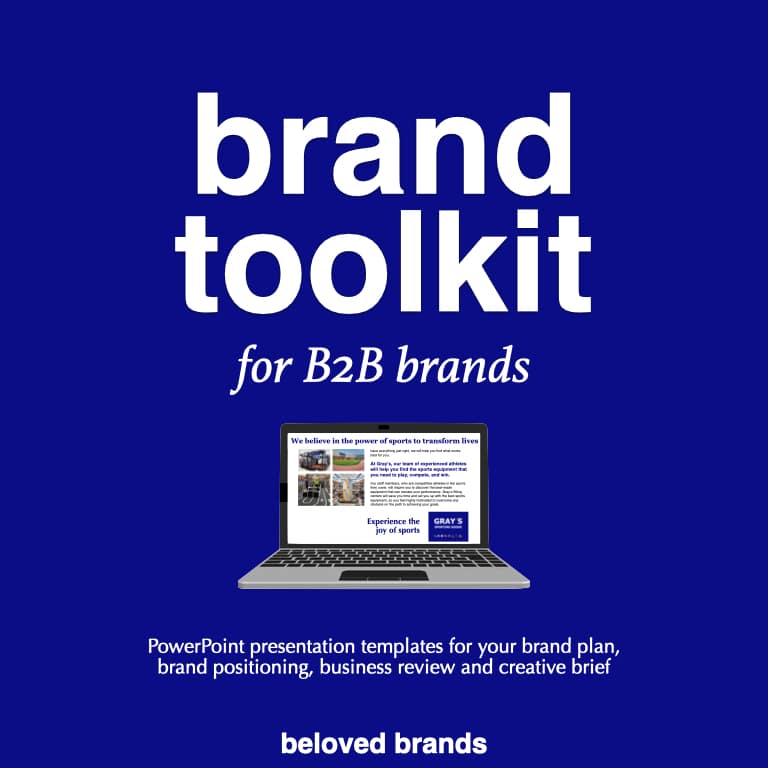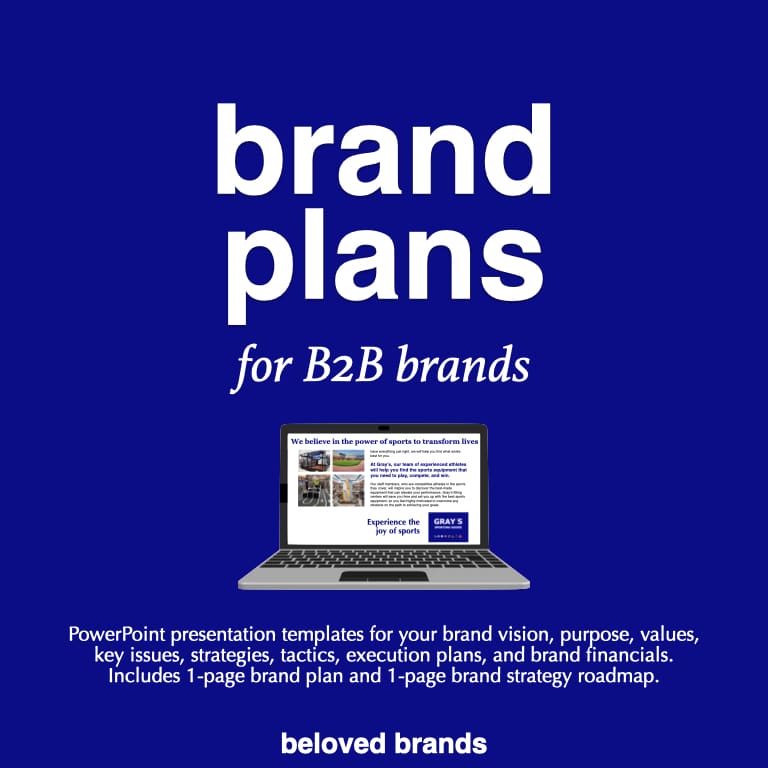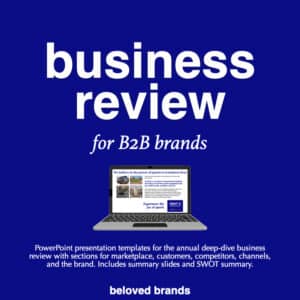I want to show you how to craft your B2B brand strategy using our Strategic ThinkBox tool so you can frame your thinking before you take action. It takes a strategically sound B2B marketer to determine how to win with brand love to attract loyal customers. As marketing rapidly evolves, B2B brand management fundamentals matter more now than ever.
Today’s B2B marketers are so busy, running from meeting to meeting, and they feel overwhelmed and confused. They have no time to think. Marketing is now about ‘getting stuff done.’ And, never about stopping and asking if it is the right stuff to do.
Meanwhile, you must take the time to court your customers to build a relationship genuinely. To move your customer from stranger to friend and onto the forever stage, you must always think. With the focus on access to big data, marketers are drowning in data that they do not even have the time to sort through it all to produce the analytical stories to help to make decisions. B2B marketers are overwhelmed by the breadth of media choices. And there is pressure to be everywhere that the quality of B2B marketing execution has suffered.
Use our Strategic ThinkBox to uncover your B2B brand strategy
I want to introduce you to my Strategic ThinkBox concept, which I have borrowed from sports. For instance, in golf, using a ThinkBox force you to consider everything you are facing before you take the shot. Look at any lakes or bunkers in the way, the wind condition, or how well you are playing that day. Then, decide on your shot strategy. As you move to a PlayBox, visualize the ideal shot, think and feel your way through the mechanics of your swing, and trust you are making the right shot. Do not overthink the strategy during the execution.
With your brand, you should use a strategic ThinkBox, to get a 360-degree view of the situation before taking action. Consider your brand’s core strength, your bond with your customers, your brand’s competitive position, and your brand’s business situation. Once you have completed your thinking, use the Execution PlayBox to see the ideal execution, think and feel your way, then trust your instincts.
B2B Brand Strategy - Table of Contents
The four questions in your Strategic ThinkBox
As I created the Strategic ThinkBox, I made it so that each of the four questions uses a forced choice to make decisions, where you must focus on only one possible answer for each question.
1️⃣ What is the core strength that will help your brand win?
Identifying your brand’s unique selling proposition will provide the foundation for your strategic direction. 🔥 Decide which of the four choices you will lead with:
- Product
- Brand story
- Customer experience
- Price
Your core strength will change your entire strategy, including the brand messages and the focus of your investment. I show a unique process for how to choose your brand’s core strength and then show you how to write smart, strategic objective statements around your core strength.
2️⃣ How tight is the bond with customers?
Understanding the depth of customer loyalty helps you tap into the emotional connection that drives business success. 💞 Start by determining where your brand currently sits on the brand love curve, whether your brand is:
- Indifferent
- Like it
- Love it
- Beloved
The goal is to tighten the bond with your customers and move them from one stage to the next. I will show you how to use brand funnel data, the voice of the customer, and market dynamics to determine where your brand sits on the brand love curve. I will outline clear game plans for each stage.
3️⃣ What is your current competitive position?
Knowing where you stand in the market allows you to leverage your strengths and exploit competitors’ weaknesses. 🏆 Regarding the competitive strategy, you must choose from one of four different types of competitive situations you find your brand operating within:
- Power players are the dominant leader in the category and take a competitive defensive stance.
- Challenger brands have gained enough power to battle head-to-head with the market leader.
- Disruptor brands have found a space so different they can pull customers away from any significant category players.
- Craft brands aggressively go against the category with a niche target market and a niche customer benefit. They are small and stay far away from the market leaders.
Each competitive situation leads to different strategy choices.
4️⃣ What business situation does your brand currently face?
Assessing your brand’s performance and environment will help you make informed decisions and seize opportunities for growth. 🌱 A brand must look at the situational strategy, which starts with understanding your brand health and looking at both internal and external factors. Choose one of four potential situations:
- Keep the momentum going
- Face a business turnaround situation
- Realign everyone behind a strategy
- Your brand is a start-up
Each situation leads to distinct strategies and leadership styles to deploy.
As you combine all four answers, you start to map out the overall strategic direction where you should focus. When writing the brand plan, I recommend you map out a specific key issue question for each of the four strategic questions in your ThinkBox.
M A R K E T I N G B O O K
B2B Brands
the b2b playbook for how to create a brand your customers will love
As a B2B marketer, you know that the key to driving growth is a strong brand. But how do you develop and execute a winning B2B brand strategy? Look no further than the B2B Brands playbook.
Prepare to think differently about your B2B brand strategy with B2B Brands. We want to challenge you with thought-provoking questions and take you through our process for defining your brand positioning. Our goal is to expand your mind to new possibilities for your brand by using real-life examples of successful B2B brand positioning strategies.
We’ll start by showing you how to create a brand plan that’s easy for everyone to follow, ensuring that all stakeholders understand how they can contribute to your brand’s success. Moreover, we guide you through the creative execution process, including how to write an inspiring brief and make decisions to achieve smart and innovative communications.
Finally, we’ll teach you new methods to analyze your brand’s performance through a deep-dive business review.
Our B2B Brands playbook offers a wealth of knowledge and insights, including B2B case studies and examples to help you learn new techniques. It’s no wonder that 85% of our Amazon reviewers have given us a 5-star rating. So, join us on this journey to unleash the potential of your B2B brand.
Using Gray's Stage Lighting to Demonstrate Strategic Thinking
We will use the fictional Gray’s Stage Lighting as a B2B brand strategy case study. Gray’s is the ultimate stage lighting product that brings the actors’ faces to life so theater patrons can see the expression on their faces from the 40th row. This lighting is battling the major mainstream competitors. It started from a small niche with a core target market of Broadway theater director fans who are beginning to love the brand.
Our B2B Strategic ThinkBox defines a brand’s key issues
To me, the key issues and strategies are the guts of your strategic plan. Take all your thinking on your brand and start organizing the best strategic questions and answers. The key issues answer, “Why are we here?” Take the summary findings of the deep-dive analysis. Draw out the significant issues that are in the way of achieving your stated brand vision.
Our methodology for finding key issues is to return to our Strategic ThinkBox with my four strategic questions model from the strategic thinking chapters. Our Strategic ThinkBox ensures you take a 360-degree view of your brand—your brand’s strength, customer bond, competitive dynamic, and business situation.
With these four questions, you need to decide on your main answer and see if your investments, communications, and execution deliver on that answer. Once the issues are expressed as questions, we can provide our strategic solutions for Gray’s Lighting.
1. What is your brand’s core strength?
- Is your core strength the product, story, experience, or price? Are your capabilities lined up to deliver?
- Is your investment lined up with building capabilities that support your core strength? What has paid off or not?
- Are you communicating your core strength? Are you using your strength to move customers?
- What is working well? What needs fixing?
Core Strength - Gray's Lighting B2B Brand Strategy assessment
Gray’s Lighting has taken a dormant HEX technology used in automotive lighting but failed due to the high price point and has created a new stage lighting product. The product lights up the faces of stage actors in a way that captures their moods. To convey this difference, Gray’s core strength is a product, but they use a “touch of magic” brand idea to break through the clutter and tempt directors to request a ‘see it for yourself’ demo. The demo has been one of the deal closers with directors.
2. How tight is the bond with customers?
- Where are you on our brand love curve; is your brand unknown, indifferent, liked, loved, or beloved?
- Who is the customer target, what knowledge and insights, and how do they match the brand’s main benefits?
- Which capabilities must you invest in to tighten the brand’s customer bond?
- What does the funnel indicate? Penetration, frequency?
Customer Strategy - Gray's Lighting B2B Brand Strategy assessment
- For Gray’s Lighting, some more renowned Broadway directors love this new product. They could become potential influencers with their peers. At the same time, they need them to push for our product, as they are a significant premium. The production houses set a budget for each show, and any added cost can cause tension between the owner, who wants happy directors, and their buyer, who watches every penny.
3. What is your competitive strategy?
- Is your brand the power player, challenger, disruptor, or craft brand?
- What is the unique positioning space you win with?
- What is the intensity of competition? Are you attacking or defending?
- Winning battles: investment, messages, innovation, channels, location?
Gray's Lighting B2B Brand Strategy assessment
- Gray’s Lighting is a startup that has disrupted the theater lighting business. The big players (GE, Philips, Osram) will follow. They have a head-start, and since theater lighting is a small niche for the bigger players, it could be 2-3 years before they have a solution. With a tighter focus on one segment, they can invest in specific claims to defend against any new entrant.
4. What is your business situation?
- Continue momentum, turnaround results, realignment, or startup?
- Wealth: share, sales, profits? Health: reputation, distribution, pipeline?
- Significant gaps that need fixing: message, distribution, innovation?
- Current drivers and inhibitors? Future opportunities and threats?
Business Situation - Gray's Lighting B2B Brand Strategy assessment
- Gray’s is two years in and just coming off the startup situation. Even after everything was set up (team, culture, positioning), Gray’s needed to look for new peripheral distribution channels before the mainstream brands did. The options include off-Broadway, concert production, or conferences. The challenge is which ones to go after next.
Transforming your strategic thinking into key issues
Looking at the example below, I have used the four Strategic ThinkBox questions to trigger my thinking. Then I developed four specific questions that fit Gray’s Lighting’s unique situation that can be used to set up Gray’s B2B brand strategy.
You may end up with multiple key issue questions matched up to one of the ThinkBox questions, or you may end up with redundant questions. With various ways to brainstorm and find the issues I recommend for the annual brand plan, focus on the top three key issues, which set up the top three strategies. A long-range strategic roadmap can typically handle five key issues and five strategies.
Other examples of B2B Brand Strategy
B2B brand strategy in the real world
FedEx
FedEx’s core strength has been its remarkable experience shipping small packages overnight, which it pioneered in the 1970s. Regarding competitive strategy, FedEx entered the market as a classic disruptor, which made it impossible for any current alternative to compete and gave the company a significant competitive advantage over UPS. However, UPS caught up in the 1980s, and most customers now view FedEx and UPS as equals.
Regarding customer strategy, FedEx remains one of the most trusted B2B brands, but UPS is almost as highly trusted. Yes, some loyal customers still love FedEx, but many are indifferent when they compare FedEx to UPS because there is no clear point of difference between them. FedEx’s bond with customers is at risk, leaving the customer’s decision to be made on price or availability.
Even with strong brand scores, the business situation is not great. With flat sales and pricing challenges, FedEx has seen its valuation fall 25% in the past few years. FedEx is stuck, wondering where to go next. E-commerce retailers and brands are building their delivery systems for direct-to-consumer service. FedEx recently lost its deal with Amazon. FedEx is a classic case where its success is a burden. The challenge FedEx now faces is to find new revenue streams, or it will face a long, steady decline, and pinpoint where to attack itself to eliminate costs from the system.
Boeing
Boeing is a product-led brand, now facing issues with their product due to recent crashes of the Boeing 737 MAX. For decades, Boeing has been one of the most respected and admired companies in the world. However, Boeing has completely mishandled its 737 MAX situation. It’s a classic case of the PR misjudgment of hoping the story goes away rather than address the root causes head-on. As a result, Boeing’s reputation, sales results, and financial outlook have all suffered. As reporters look deeper, they question Boeing on its commitment to safety, suggesting the company is more focused on profits and cost efficiency than safety.
From a customer view, Ed Sims, the WestJet Airlines CEO, was quoted for his evaluation of Boeing saying, “I would grade it no higher than a B. I expect A-plus service from every supplier to WestJet, just as we expect our customers to evaluate us in the same way. I think Boeing has missed a beat, frankly, in the way that they have responded to this crisis.” That is never a comment a brand wants to hear from their customer.
Boeing competes head-to-head with Airbus, similar to how Coke and Pepsi battle each other. Every loss by one brand is the other brand’s gain. In the months following the 737 MAX crisis, Boeing’s market capitalization fell by $30 billion, while Airbus quickly climbed $20 billion. Moreover, Airbus has used the crisis to race ahead of Boeing with new orders and deliveries. The challenge for Boeing is how to put the crisis behind it and refocus on innovation to get back into a competitive position with customers.
Microsoft
Regarding enterprise software, Microsoft is the dominant power player B2B brand, having achieved a near-monopoly in the PC market with core products such as Windows, Office, and Outlook. From 2000 to 2012, their valuation felt stuck, relying on a steady stream of sales for business offices, but Microsoft didn’t seem to know where to go next, with failures in mobile, music, and search engines. The brand needed a realignment to steer it toward the future. In the last few years, Microsoft’s growth has shifted investment and attention to its B2B enterprise business, behind the Azure cloud business, which includes on-premise servers and software and enterprise consulting services.
Arguably, Microsoft has shifted its B2B focus from product-led to experience-led. The valuation for Microsoft is up four-fold, surpassing $1 trillion. Abandoning the monopoly mindset has opened up innovation with the Internet of Things (IoT), connecting everyday internet connections with data collection and automation. As the business transforms, Microsoft needs to continue its momentum and competitively battle cloud offerings from Amazon and Google.
Marriott International
Marriott is the choice hotel of the business executive, not just because of the quality of its hotel rooms but the exceptional Marriott Rewards program that makes staying in its hotels a must-have by making loyalty more enticing. Following the acquisition of Starwood Hotels, Marriott is now the power player brand by adding Westin Hotels, Ritz Carlton, and the St. Regis brands. Marriott takes a house of brands approach to the market, but internally, the Marriott Rewards program unifies the company as it approaches the business traveler.
The Marriott Rewards program is the company’s secret sauce among B2B customers, shifting Marriott from a product-led brand into an idea-led brand. While hotels will bid to procurement departments to be preferred vendor, business executives have become so addicted to Marriott Rewards that they insist on staying at a Marriott. With the stock up eightfold over the last decade, Marriott needs to continue its momentum.
The recent launch of the Marriott Bonvoy Rewards program goes beyond just earning and redeeming free hotel stays, including 40 airline partners and the ability to book flights and cars using only points. This reward program is its new power play, which beats any competitive offering. Marriott is a great B2B case study. It proves that, instead of treating a company as your customer, B2B brands should now manage every employee at a company as a potential customer.
Although Facebook is primarily a consumer-facing brand, its revenues come from B2B media sales. Facebook is an idea-led brand and the dominant power player, willing to bully any competitor who threatens it.
In terms of its customer bond, five years ago, Facebook was on the verge of becoming a beloved brand. Yet Facebook’s arrogance and hunger for even more power have eroded its trust with users, putting its future B2B media revenues at risk. There remains doubt about how Facebook will handle privacy, political interference, and concerns over the accuracy of its audience numbers – uncertainty that continues to cloud Facebook’s trust. Mark Zuckerberg must be more forthcoming and honest in portraying his brand. The question Facebook should focus on is how to tighten its bond with users.
Looking at its business situation, Facebook still sees significant momentum with revenue increases of 20-30%. Facebook needs to regain its trust because the most significant risk to its arrogance is the threat of government regulations that would severely cut into future revenues.
Our brand toolkit for B2B brands is our most comprehensive template helps you communicate your brand plans, brand positioning, business review and creative briefs.
Our brand plan template offers slides for vision, purpose, analysis, key issues, strategies, and execution plans, ensuring a thorough approach to your brand’s development. The brand positioning template guides you through defining your target profile, crafting a brand positioning statement, and developing a unique brand idea, concept, values, story, credo, and creative brief. Finally, our business review template provides slides for an in-depth analysis of the marketplace, customers, competitors, channels, and your brand.


